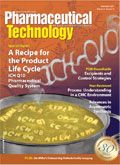Self-destruction
Poor processing and misguided projections lead to trashed product.
The cure for shedding
"During an inspection of a liquid parenteral product, we noted an unusual number of vials with what appeared to be stopper particles," notes our GMP Agent-in-Place. "We don't usually find such particles in our inspection, so we investigated further. In some instances, several such particles appeared in one vial. Upon examination of the particles, it looked as if the stopper was shedding.

Control
"It turned out that the vendor hadn't cured one lot of stoppers properly. Some of the stoppers were so insufficiently cured that the rubber was not cross-linked and could shed. We ended up destroying several already filled but not yet released batches and the remainder of that vendor lot of stoppers."
In poor taste
"In our company, we had a guy who was responsible for investigating complaints," laughs our GMP Agent-in-Place. "Because part of his responsibility was complaint trending, we called him 'Trend Man.' One of our products was a liquid antacid, and we received some complaints of a bad-tasting product. Our Trend Man went beyond visual examination of the product and actually tasted the complaint vials to determine whether he could verify the users' complaint.
"We were all grossed out at that. After all, some customers would drink directly from the bottle over a period of weeks. Who knows what kind of microbial contamination the returned product might contain?"
Not all it's cracked up to be
"It was a new product, and we needed to bring in supplies for the estimated usage," declares our GMP Agent-in-Place. "Because the gelatin capsules had a long lead time, and there was a huge sales forecast, a large order for capsules was placed. The product sold well but not as well as forecast, so there was a buildup of capsule-shell inventory. This resulted in capsules aging.
"The capsules were stored in the warehouse, which had temperature control but no moisture control. Although the capsules were in double plastic bags, during the winter months they dried out. This caused the capsules to become brittle.
"When we did get around to using them, they would crack during encapsulation, resulting in customer complaints. We did finally balance our ordering and inventory with the sales, and had to destroy some of the oldest capsule shells. We also moved the inventory to a humidity-controlled area—which is what we should have used in the first place."
Make to plan, launch, and destroy
"We love new products," our GMP Agent-in-Place declares. "They are the lifeline of our business. So when we were nearing approval of a new product, the marketing manager decided that he wanted 40 batches available for launch. So we worked three shifts for several months making inventory. I had spoken with the marketing manager and the corporate vice-president of production several times to ask whether this was a 'real' forecast, with always the same answer: 'Make it.' So we did.
"Approval came, and the orders only trickled in. We sold only one batch the first 12 months! The other 39 batches were destroyed and the product was discontinued. While in one sense I felt vindicated because my skepticism proved right, I knew this was a very expensive lesson."
Pharmaceutical Technology's monthly "Agent-in-Place" column distills true-life cautionary tales from the secret files of Control, a senior compliance officer. If you have a story of clueless operators, oblivious management, inopportune lapses of judgment, or Murphy's Law in action, please send it to Control at AgentinPlace@advanstar.com We won't use any names, but if we do use your tale of disaster, courage, or just plain weirdness, Control will send you a coveted Pharmaceutical Technology t-shirt.
